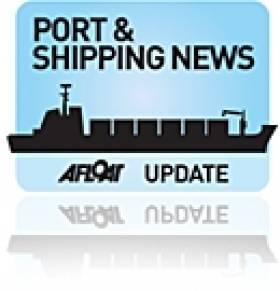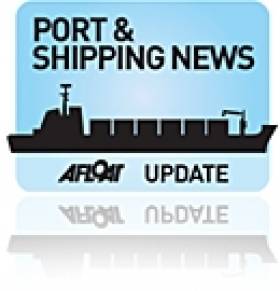Displaying items by tag: BreakBulk
Port & Shipping Volumes Continue Slowdown in 3rd Quarter
#PORTS & SHIPPING- The volume of shipping and port traffic through the Republic of Ireland continued to decline during the third quarter of 2011, according to the latest analysis of traffic figures released by the Irish Maritime Development Office (IMDO).
Results from third quarter data indicate that only 1 of the 5 principal freight segments had any growth over the third quarter, while all other segments declined compared to the same period last year as outlined below in the key third quarter data:-
• Lift-on/Lift-off (lo/lo) trades were down 5%
• Roll-on/Roll-off export traffic was down by 2%
• Dry bulk volumes increased by 2%
• Break bulk volumes were down by 3%
• The Tanker/Liquid bulk market was down 7%.
For a more in-depth analysis of each freight-transport mode issued by the IMDO and accompanied by graphic charts click HERE. In addition to compare the 3rd quarter figures with the previous 2nd quater for this year click HERE.
Port and Shipping Volumes Show Second Quarter Slowdown
Below is a list of figures for each transport mode based for the second quarter of 2011.
•Lift-on/Lift-off (lo/lo) trades remained static at 0%.
•Roll-on/Roll-off (ro/ro) export traffic was down by 1%.
•Dry bulk volumes increased by 5%,
•Break bulk volumes were down by 6%
•The Tanker/Liquid bulk market was down 6%.
For more in-depth analysis of each freight-transport mode issued by the IMDO and accompanied by graphic charts click HERE.
Shipping Volumes Up in First Quarter
First quarterly figures for 2011 show that volumes of shipping and port traffic on the majority of principal sectors grew, according to the Irish Maritime Development Office (IMDO).
The figures below outline a moderate trade volume growth in four out of the five key freight segments: Lift-on/ lift-off (lo-lo), Roll-on/Roll-off (ro-ro),dry-bulk, break-bulk and the tanker/liquid market.
• Total lift-on/ lift-off (lo/lo) trades volumes grew by 3%.
• Roll-on/Roll-off export traffic was also up 2% per cent on an all island basis.
• Dry bulk volumes through ROI ports increased by 21%,
• Breakbulk volumes were also up 25%
• The tanker/liquid market was the only sector to record a decline, down by -12% compared to the same period last year.
For further information about the figures, charts and a summary released from the IMDO click here
IMDO Release Third Quarter Shipping Figures
The latest figures announced by the Irish Maritime Development Office (IMDO) has revealed that the volume of goods passing through Irish ports increased across all the main shipping segments during the 3rd quarter of 2010 compared to the same period last year.
Exports of container were up 12%, roll-on/roll-off volumes on Ireland – UK routes is up 3%, dry bulk volumes up 40%, and liquid bulk up 19%.
Containersized traffic shipped through ROI ports recorded a quarter-on-quarter volume growth for the 3rd quarter 2010 up 4% to 218,377 twenty equivalent units (TEU). This was primarily as a result of strong export demand, which rose by 12% in the last quarter.
This sector is characterized by export traffic to USA and Asia largely influenced by the multinational chemical and pharmaceutical industries and also established indigenous Irish exporting companies. The other factor contributing to the aggregate rise was the increase in container imports during this period. This was also the first quarter-on-quarter growth in import volumes since the beginning of 2009.
Roll-on/roll-off (ro/ro) traffic to the UK from ROI ports continued to make a steady recovery up 3% for the 3rd quarter which is consistent with overall figures for the 9 months from Jan – Sept period which is up 3%, to 568,833 units. The ro/ro segment is largely weighted towards services to and from the UK which remains our largest trading partner.
In the dry bulk trade, traffic through all Irish Ports continued to recover some of the large volume losses experienced in 2009 and is up 40% for the 3rd quarter compared to the same period last year and 26% for the first 9 months of 2010. Part of the rise is attributed to strong global demand for ore and mineral products such as alumina, while domestic demand in the agricultural sector experienced a rise in imports of grains, feeds and fertilizers. While the overall picture is positive; the main volume gains are distributed to the larger ports with some of the smaller regional ports still in negative territory.
Break bulk volumes of construction related products fell again in the third quarter, bringing the total decline for the third quarter to -10%. Between 2008 and 2010 over 700,000 tonnes of break bulk commodities have been lost from the market. Importantly the fall off in volumes has not slowed in 2010 with an average quarterly drop of 10%.
Liquid bulk volume rose in Q3 by 19% year-on-year. However overall volumes for the first 9 months of the year remain unchanged.
The outlook for the remainder of the year suggests that some volume recovery in the main market segments will be achieved this year. However the total volume in many segments are still running at 35% less than 2007 volumes. Many shipping operators also comment that while export volumes have remained resilient over this period, there are few new companies emerging in the export market. Otherwise there are concerns about the impact of austerity measures in the Euro zone and at home.
Source: Glenn Murphy, Director of the IMDO. For more about the IMDO logon here.


























































